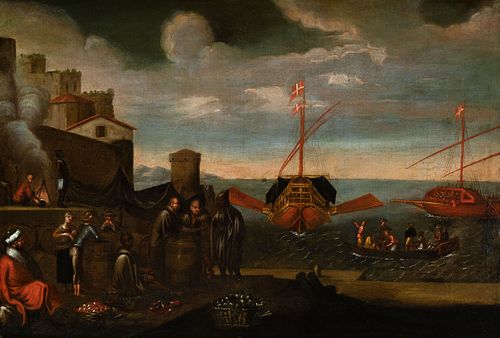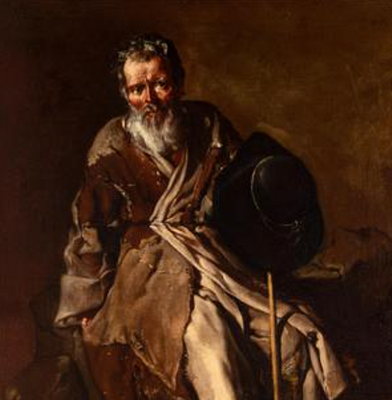Spanish school of the seventeenth century. Attributed to MIQUEL BESTARD (Palma de Mallorca, 1592 - 1633). "Group of slaves in the port". Oil on canvas
Lot 57
About Seller
Setdart Auction House
Carrer Aragó 346
Barcelona
Spain
Setdart Subastas was born in 2004 and is currently the first online art auction in Spain with solidity, prestige and reliability guaranteed by our more than 60,000 users. Setdart has a young, dynamic and enterprising team ready to successfully manage the purchase and sale of art works through custom...Read more
Estimate:
EUR€10,000 - EUR€12,000
$10,752.69 - $12,903.23
Absentee vs Live bid
Two ways to bid:
- Leave a max absentee bid and the platform will bid on your behalf up to your maximum bid during the live auction.
- Bid live during the auction and your bids will be submitted real-time to the auctioneer.
Bid Increments
| Price | Bid Increment |
|---|---|
| EUR€0 | EUR€10 |
| EUR€200 | EUR€25 |
| EUR€500 | EUR€50 |
| EUR€1,000 | EUR€100 |
| EUR€3,000 | EUR€200 |
| EUR€5,000 | EUR€500 |
| EUR€10,000 | EUR€1,000 |
| EUR€20,000 | EUR€2,000 |
| EUR€50,000 | EUR€5,000 |
About Auction
By Setdart Auction House
Jun 1, 2021
Set Reminder
2021-06-01 09:45:00
2021-06-01 09:45:00
America/New_York
Bidsquare
Bidsquare : OLD MASTERS & SCULPTURE - Day 2
https://www.bidsquare.com/auctions/setdart-auction-house/old-masters-sculpture---day-2-6999
Setdart Auction House sofia@setdart.com
Setdart Auction House sofia@setdart.com
- Lot Description
Spanish school of the seventeenth century. Attributed to MIQUEL BESTARD (Palma de Mallorca, 1592 - 1633). "Group of slaves in the port". Oil on canvas. Re-lined With Majorcan frame of the time in wood carving. Size: 77 x 114 cm; 97 x 134 cm (frame). If something characterized the painting of Miquel Bestard, Majorcan painter formed in the mannerist tradition and active in the first baroque, were the complex and extravagant compositions. His canvases, determined by large formats and novel themes, included in the same support views of Mallorca from the port, fires of Troy and naval combats. On this occasion we present a magnificent port view in which a stop on a slave route is reproduced in detail. It is a scene immersed in the dynamism and hustle and bustle that characterized this type of composition, with the slaves in the foreground, conversing around a drum while patiently awaiting their departure. Other characters trade in the bustling place, selling tinderboxes and other goods. Two ships with Danish flags flying from their masts stand out in the calm waters of the sea. To accentuate the drama and commotion of the scene, of clear Flemish heritage, the painter plunges the first terms in the gloom, giving the waters of the sea a dark and ominous tone, which is clarified in the background reinforcing the construction of the space in depth. The scene in general is treated with a descriptive and enormously narrative language, typical of Bestard. Due to its formal characteristics we can attribute this work to Miquel Bestard, a Mallorcan painter trained in the Mannerist tradition and active in the early Baroque. His production can be grouped into two distinct blocks: religious painting on the one hand, made for various Majorcan churches and convents, and profane motifs on the other, which include views of Mallorca from the port, fires of Troy and naval battles. The latter are large works, and earned their author the nickname of "the mad painter" for the fantasy and extravagance of his landscapes. He also produced works related to the figure of Ramon Llull, such as "Scenes from the life of Ramon Llull" (private collection), "Lapidation of Ramon Llull" (Sant Francesc church, Palma), "Ramon Llull at the Council of Vienne" (idem) or "Ramon Llull" (Col-legi de la Sapiència, Palma). Within his religious production it is worth mentioning his canvases dedicated to the Inmaculada de Can Vivot and the churches of Monti-Sion, Sant Francesc and San Alonso Rodríguez (Palma). On occasions, Bestard unites religious themes with landscape painting, in works generally of considerable dimensions, highlighting paintings such as "Martyrdom of Saints" (private collection, Palma) and "Mythological Fable" (idem). Bestard was, despite his early death, a successful painter, with abundant and ambitious commissions, as can be deduced from his use of monumental formats, and hence he could freely devote himself to such a varied subject matter, including landscape and mythology in addition to the religious themes of the time. He was even known outside Mallorca, as evidenced by several commissions from Catalonia. The inventories of goods of the time confirm that there were many works by his hand in Mallorca, probably part of a serial production that the painter sold easily. Currently, works by Miquel Bestard are kept in the City Hall of Palma and the Museum of Mallorca, as well as in several churches and monasteries of Mallorca, and in various private collections. On the other hand, his figure was recovered in 2007 through the exhibition "Cendres de Troia. The painter Miquel Bestard", held at the headquarters of the Fundació Sa Nostra, in Mallorca, and on the occasion of which a catalog signed by Marià Carbonell Buades was published.
- Shipping Info
-
In-house shipping available. Please inquire at admin@setdart.com.
-
- Buyer's Premium



 EUR
EUR CAD
CAD AUD
AUD GBP
GBP MXN
MXN HKD
HKD CNY
CNY MYR
MYR SEK
SEK SGD
SGD CHF
CHF THB
THB

















